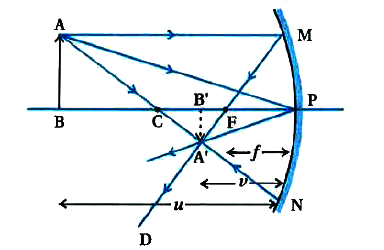Obtain the magnification by lens after giving its definition. Solution in Gujrati
The ratio of the size of the image obtained by lens to that of the object is called magnification.


In figures (a) and (b), convex and concave lenses are shown respectively.
Object height AB = h, Image height A.B. = h. Object distance BP = u, Image distance B.P = v
Right angle triangles ABP and A.B.P are similar triangles.
∴ABA.B.=BPB.P.
∴h−h.=vu [∵ According to sign convention]
∴h.h=vu
∴ Magnification m = vu
Magnification is negative for real image and positive for virtual image.
Topper's Solved these Questions
- RAY OPTICS AND OPTICAL INSTRUMENTSBOOK - KUMAR PRAKASHANCHAPTER - RAY OPTICS AND OPTICAL INSTRUMENTSEXERCISE - SECTION - A (TRY YOURSELF)
74 Videos
- RAY OPTICS AND OPTICAL INSTRUMENTSBOOK - KUMAR PRAKASHANCHAPTER - RAY OPTICS AND OPTICAL INSTRUMENTSEXERCISE - SECTION-B (NUMERICALS)(NUMERICAL FROM TEXTUAL ILLUSTRATIONS)
17 Videos
- MOVING CHARGES AND MAGNETISMBOOK - KUMAR PRAKASHANCHAPTER - MOVING CHARGES AND MAGNETISMEXERCISE - SECTION D (MCQs ASKED IN COMPETITIVE EXAMS)
34 Videos
- SAMPLE QUESTION PAPER BOOK - KUMAR PRAKASHANCHAPTER - SAMPLE QUESTION PAPER EXERCISE - PART-B SECTION-C
5 Videos
Similar Questions
Give range of wavelength of visible light.
View SolutionSuppose that the lower half of the concave mirror.s reflecting surface as shown in figure is covered with an opaque (non-reflective) material. What effect will this have on the image of an object placed in front of the mirror ?

View SolutionElectric charge Q having mass M moves on a circular path of radius R with velocity →v, perpendicular to uniform magnetic field B. When a particle completes one revolution, work done by the field is _______
View SolutionTwo charges –q and +q are located at points (0, 0, –a) and (0, 0, a), respectively.
(a) What is the electrostatic potential at the points (0, 0, z) and (x, y, 0) ?
(b) Obtain the dependence of potential on the distance r of a point from the origin when r/a>>1 .
(c) How much work is done in moving a small test charge from the point (5,0,0) to (–7,0,0) along the x-axis? Does the answer change if the path of the test charge between the same points is not along the x-axis?
View SolutionA lens of power 16D is used as a simple microscope. In order to obtain maximum magnification, at what distance from the lens
View SolutionTo obtain a magnification of, -0.5 with a convex lens, the object should be placed:
View SolutionThe lens A produces a magnification of, −0.6 whereas lens produces a magnification of +0.6.
a)What is the nature of lens A?
What is the nature of lens B?
View Solutionएक योगिक सूक्ष्मदर्शी के अभिदृश्यक - लेंस द्वारा आवर्धन 8 है यदि सूक्ष्मदर्शी की आवर्धन -क्षमता 32 हो, तो अभिनेत्र - लेंस द्वारा आवर्धन ज्ञात कीजिए ।
View Solutionउत्तल लेंस के मुख्य फोकस की परिभाषा दें।
View Solutionलेंसो के संयोग में कुल आवर्धन प्रत्येक लेंस के आवर्धन के गुणनफल के बराबर होता है।
View SolutionObtain the equation for lateral magnification for thin lens.
View SolutionDerive the equation for thin lens and obtain its magnification .
View SolutionIn a simple microscope to obtain higher magnification, the focal length of convex lens should be ________-
View SolutionObtain the equation for lateral magnification for thin lens.
View SolutionObtain the equation for lateral magnification for thin lens.
View Solution
